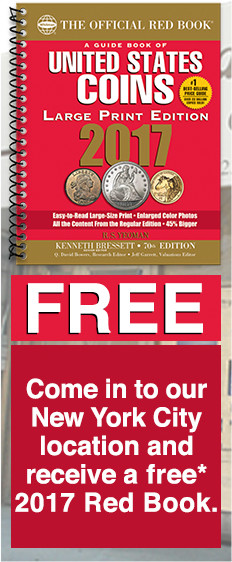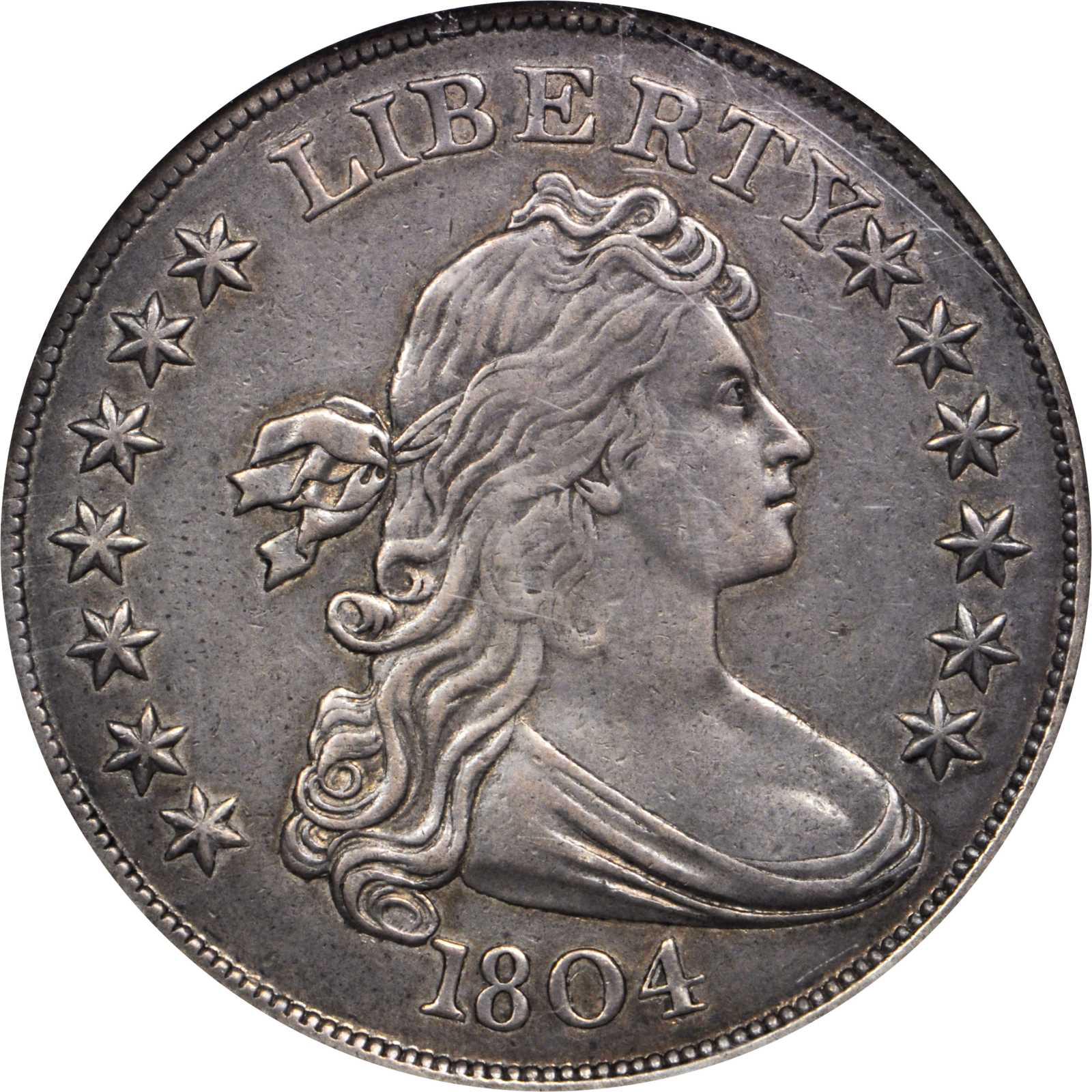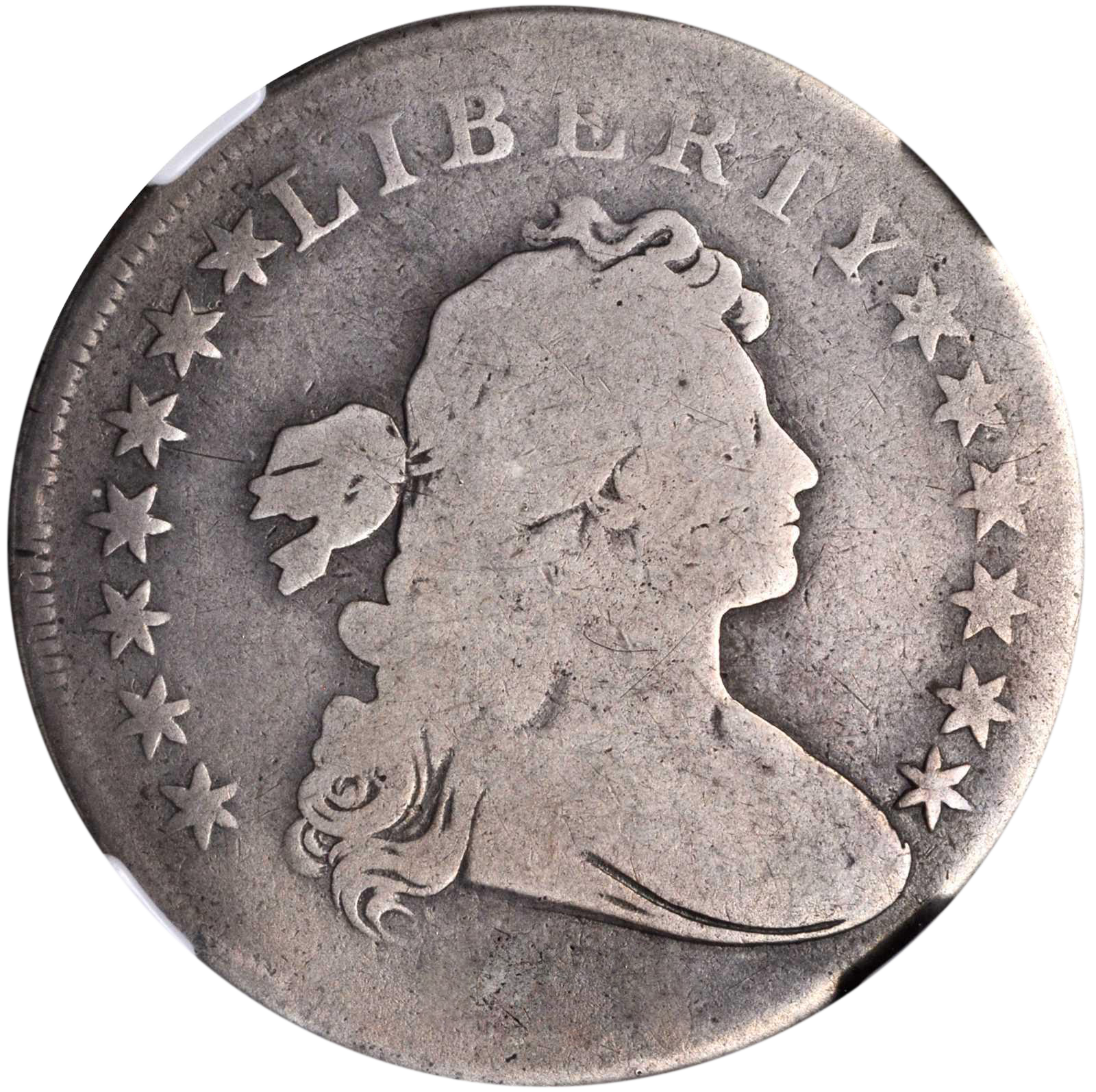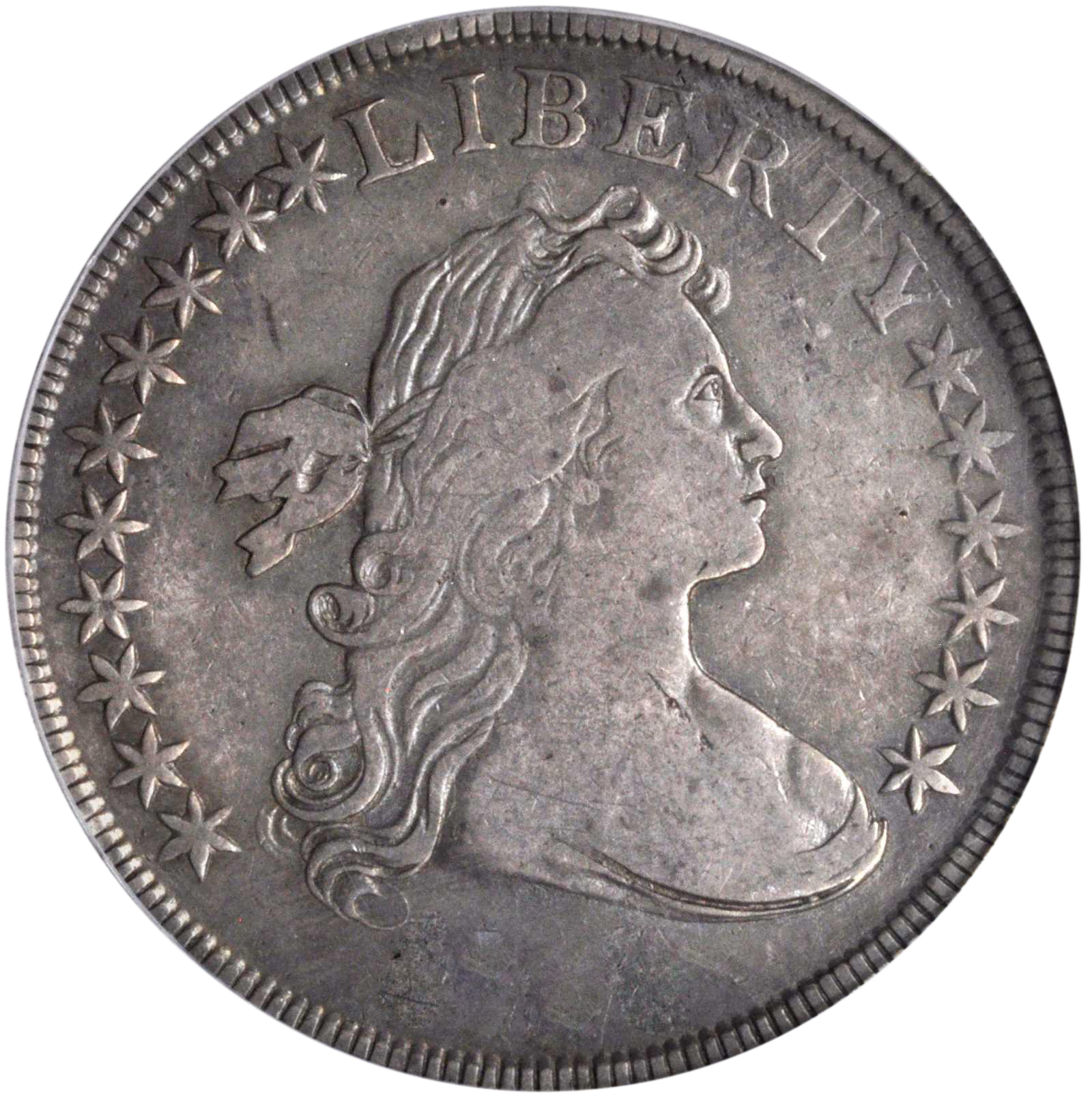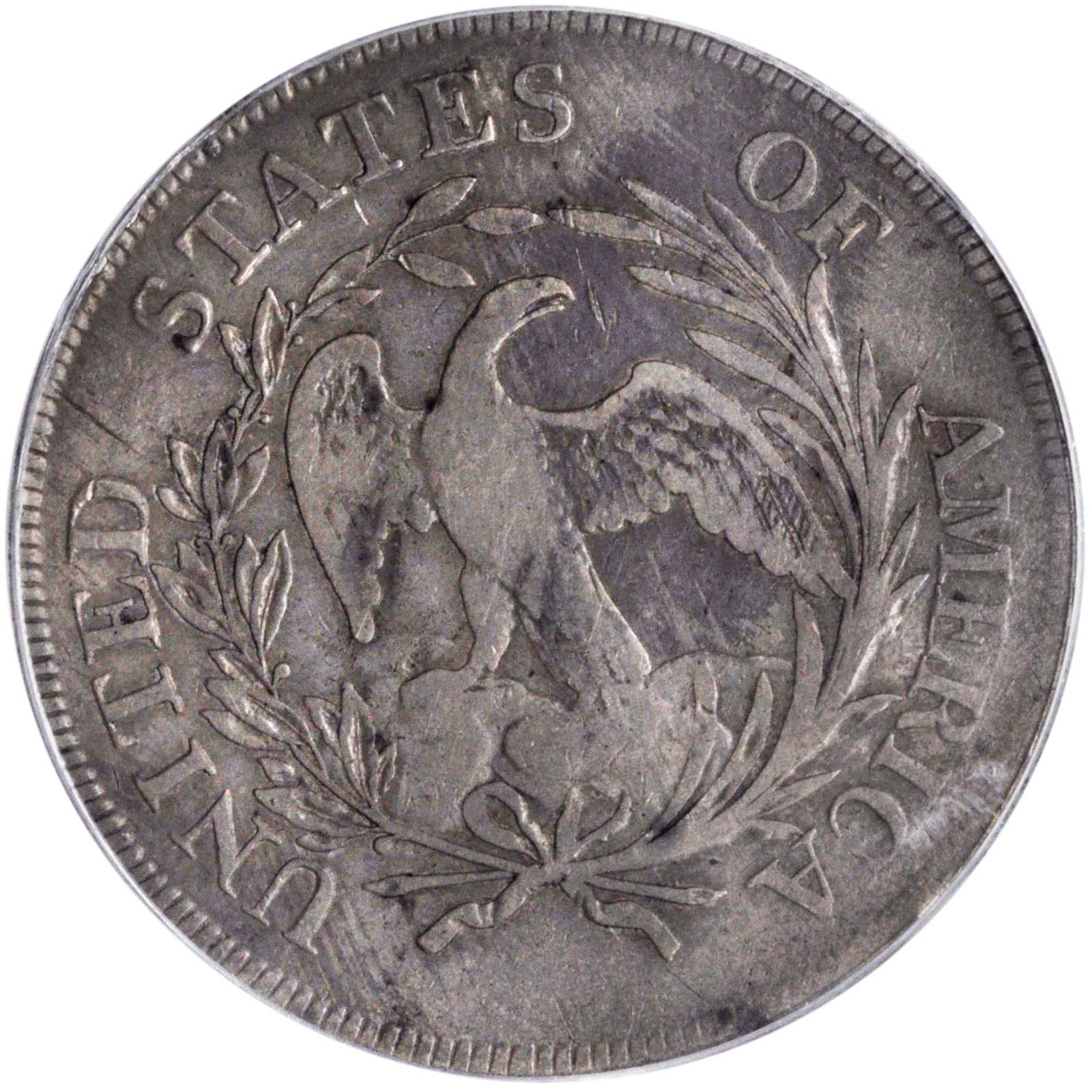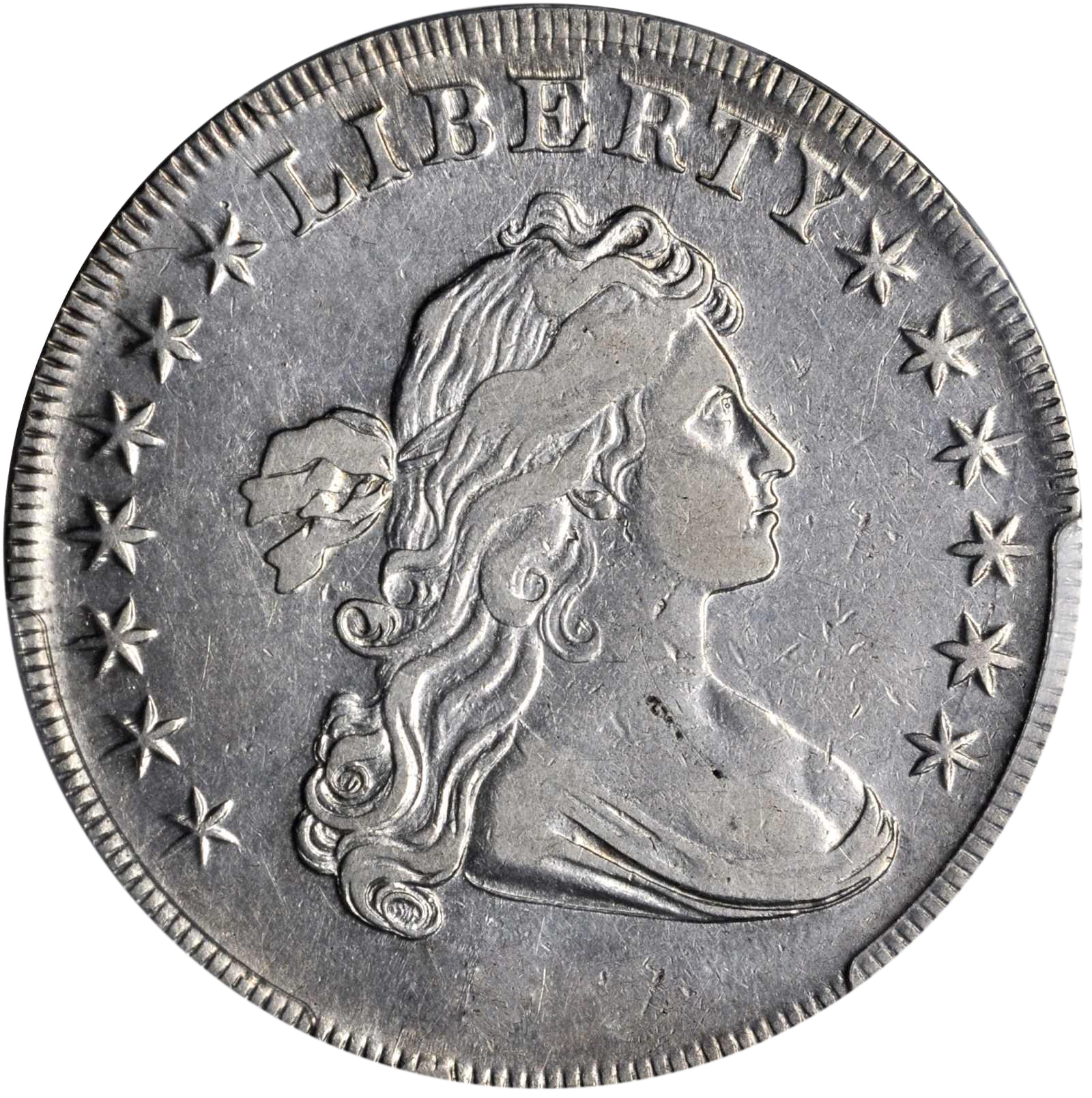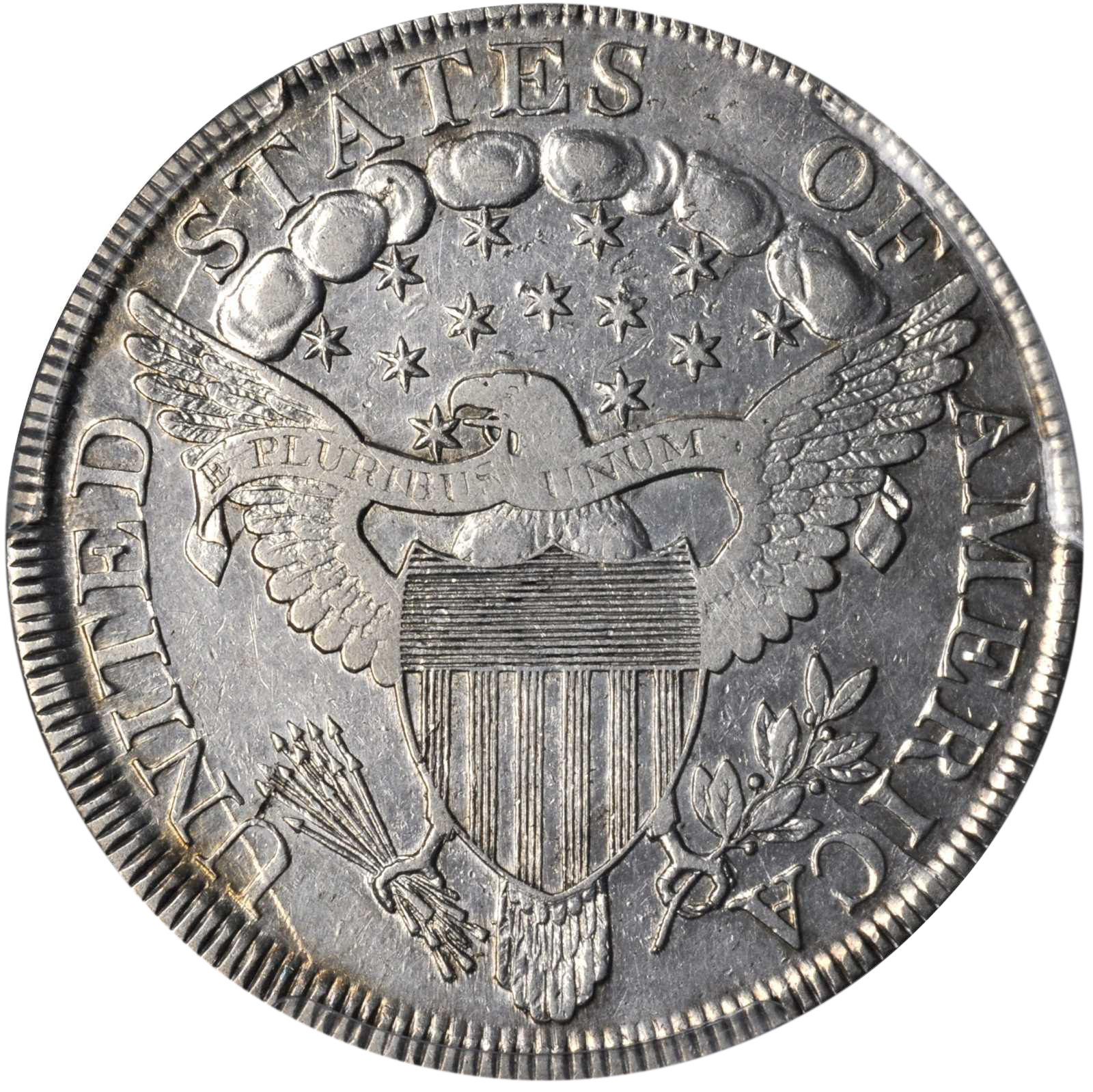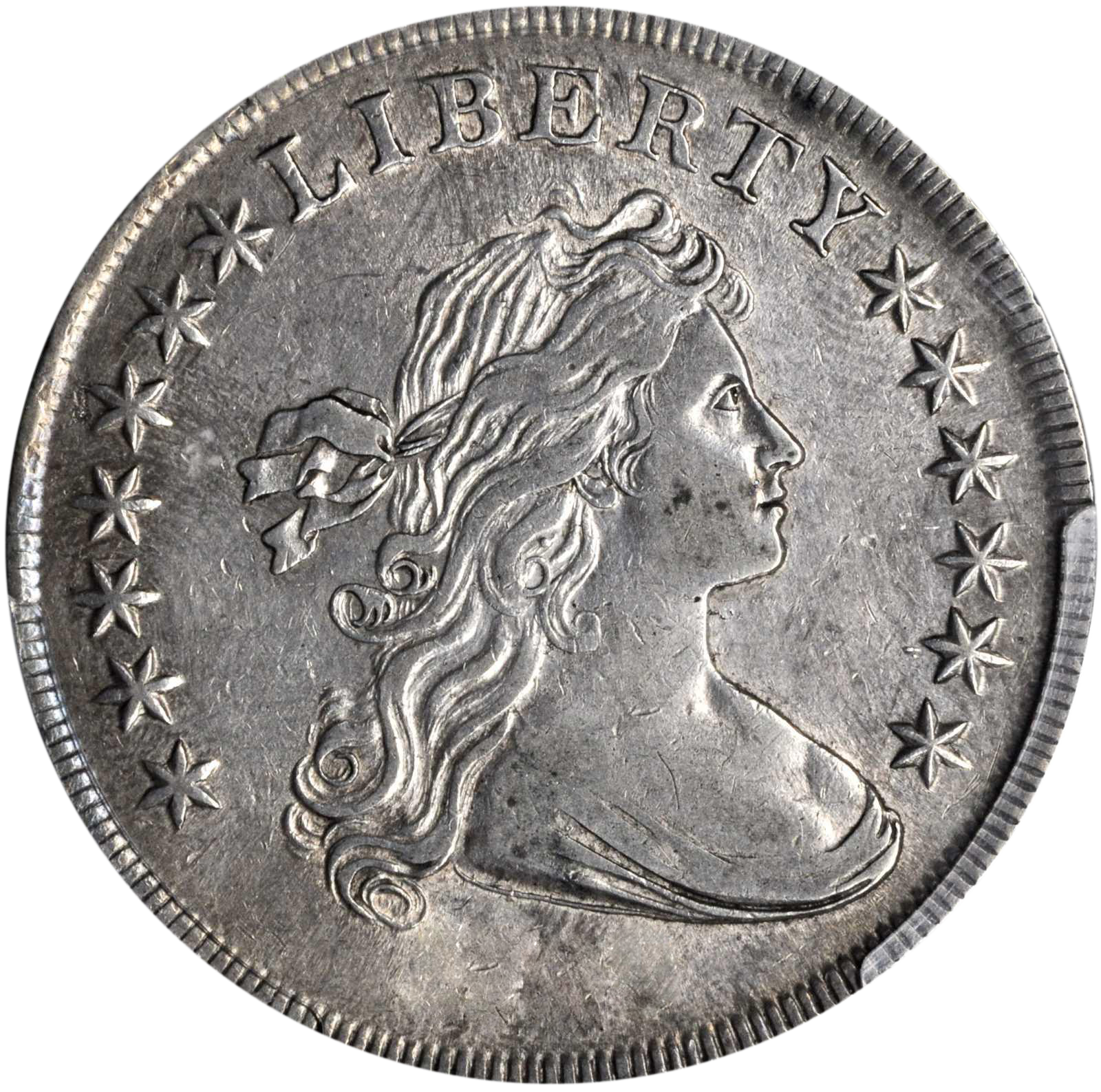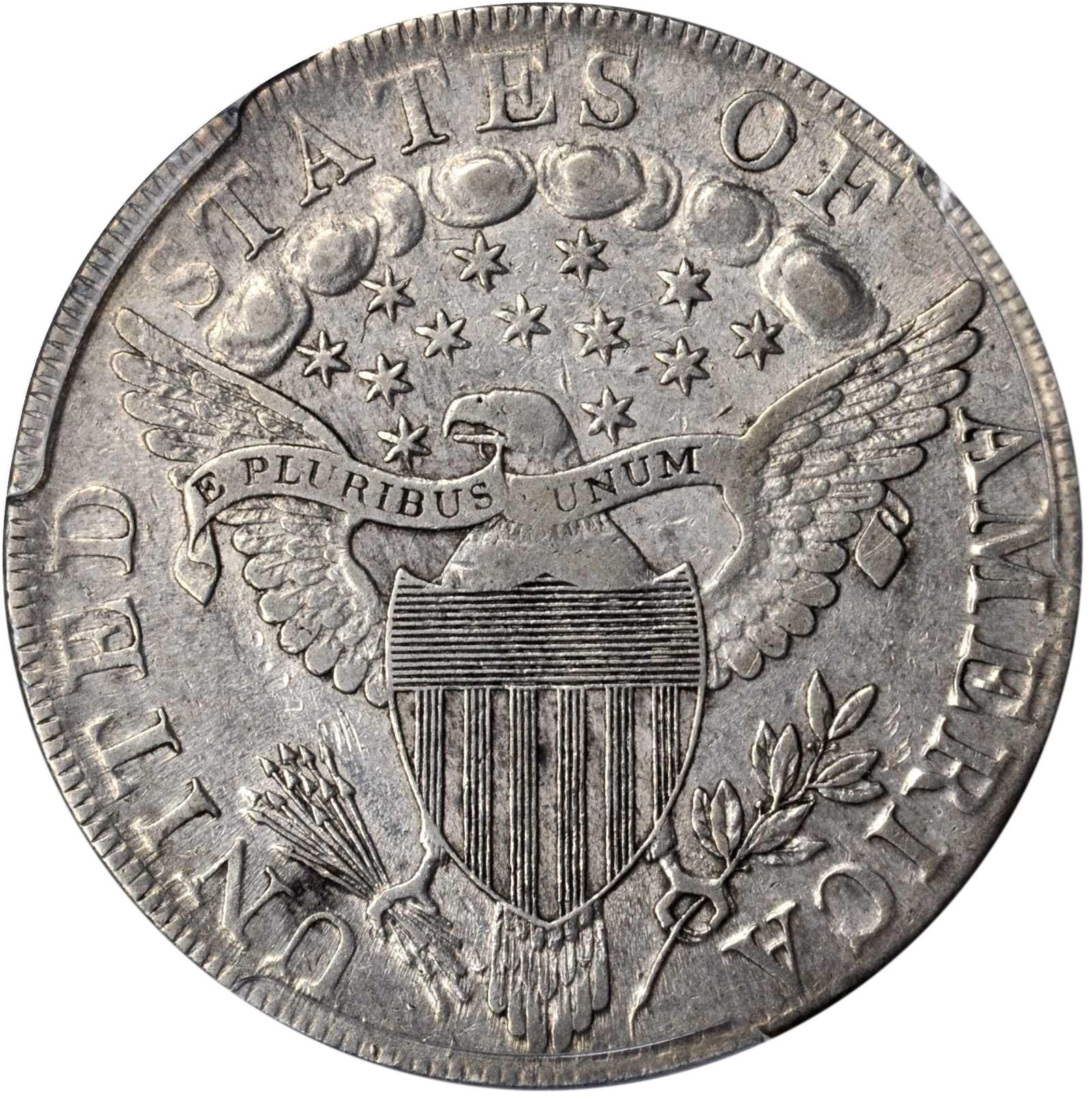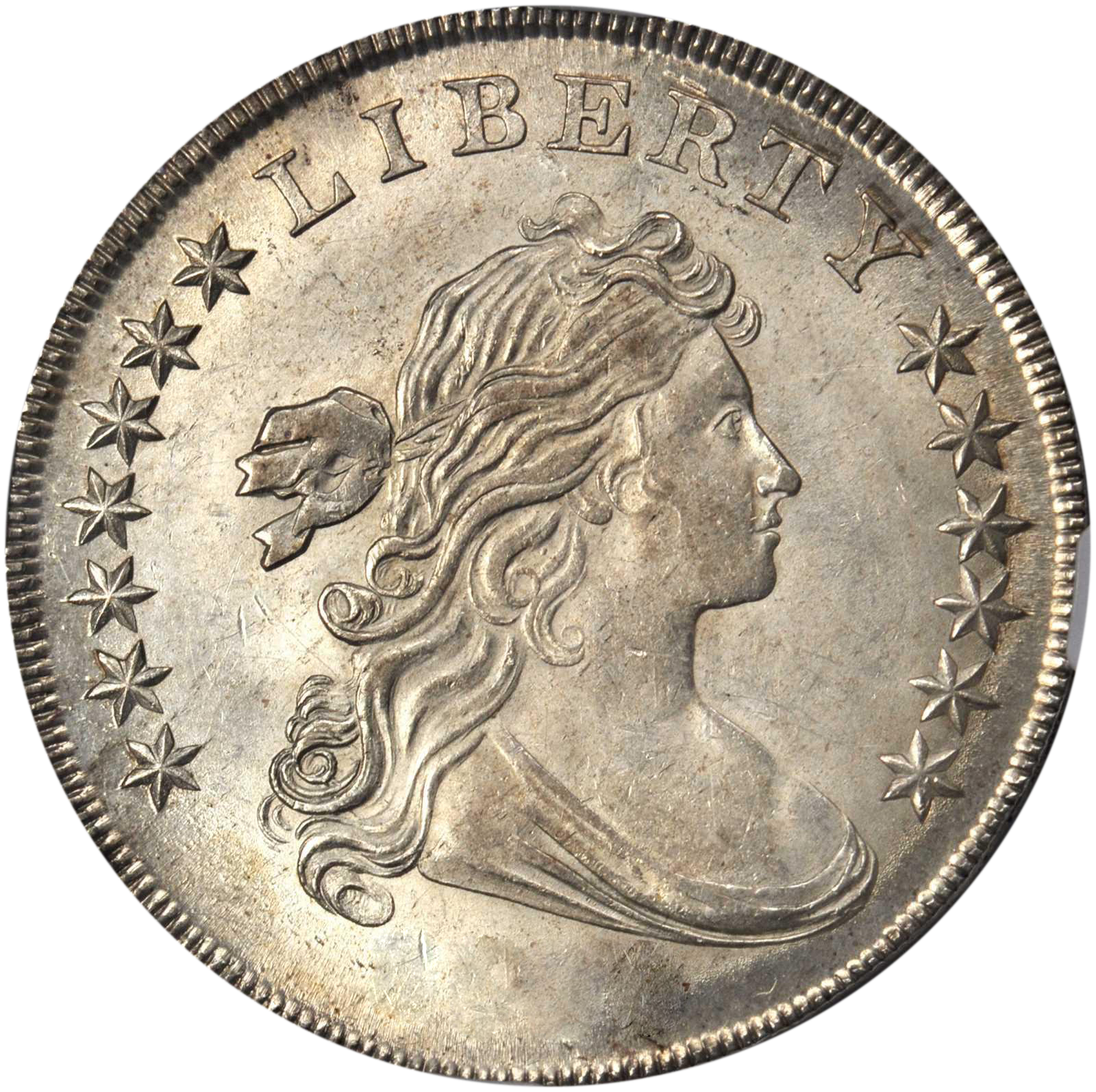1804 BB-306 Class III Post-1858 Proof Strike Draped Bust Silver Dollar
$340,000
$1,275,000
$1,700,000
$2,125,000
History, Value, and Price Guide for 1804 BB-306 Draped Bust Silver Dollar
Value of Class III 1804 Draped Bust Silver Dollar
“Restrikes” Circa 1858 or Later
History:
1. Berg Specimen. 1858-1872: Believed to have been struck at the Philadelphia Mint during this time period. | 1875: Captain John W. Haseltine, Philadelphia dealer. | 1870s: Koch & Co., Vienna. | 1876, circa: J.W. Haseltine was a likely “intermediary,” although no facts are known. The story goes that Haseltine found it in the possession of Koch & Co., and bought it for his inventory or for the following client. | 1876, circa-1883: O.H. Berg, Baltimore, Maryland. | 1883, May 23-24: J.W. Haseltine, Berg Collection, lot 568. | 1883: George W. Cogan, agent for Thomas Harrison Garrett. | 1883-1888: Thomas Harrison Garrett, Baltimore, Maryland. | 1888-1919: Thomas Harrison Garrett estate and Robert Garrett. | 1919-1942: John Work Garrett, who lived at Evergreen, the home of his father. Evergreen was subsequently given to The Johns Hopkins University. | 1942-1980: The Johns Hopkins University, Baltimore, Maryland, under the curatorship of Sarah Elizabeth Freeman, Carl W.A. Carlson, and Susan Tripp. The coin was kept at Evergreen for a long period of time, but was later taken with most of the rest of the Garrett Collection to a bank vault in downtown Baltimore for safekeeping. | 1980, March 26-27: Bowers and Ruddy Galleries, Garrett Collection, lot 698. | 1980: The partnership of Pullen & Hanks in combination with Santa Colavita, the latter having a 1/3 interest. | 1980-1982: Sam Colavita, New Jersey rare coin dealer, who purchased the interest of Pullen & Hanks on April 17, 1980. For a time it was offered for sale through Texas dealer Ed Hipps. | 1982, February 6: Pullen & Hanks, Long Beach Collector Series I Sale, Long Beach, lot 1076, but not sold. | 1982: Owned by Sam Colavita, but continued on consignment with Pullen & Hanks, who in the same year transmitted it by private treaty to the following. | 1982-1984: Mike Levinson, Houston, Texas, who traded eight acres of land in El Paso, Texas, for it. | 1984-1986: Pennsylvania private collection. | 1986, June 24-25: Included as an added consignment in the Harry Einstein Sale, Bowers and Merena, lot 1736. | 1986: Rarities Group, Inc. | 1986, November: American Coin Portfolios, agent for the following. | 1986 to: Private New York state collector, Mrs. Sommer. | Accompanied by Martin Logies and Melissa Karstedt, Mrs. Sommer delivered this specimen to the Numismatic Guaranty Corporation January 2005, at which time it was encapsulated as PR-55. Subsequently traded to a private Southern California collector. 402.8 grains. Edge lettering blundered and doubled in areas. Double struck on reverse. Reverse slightly rotated.
2. Adams Specimen. 1858-1872: Believed to have been struck at the Philadelphia Mint during this time period. | 1875-1876: Captain John W. Haseltine, Philadelphia dealer. | 1876, January: “The first time Haseltine exhibited this coin was while waiting for the beginning of the sale of the Jewett collection in New York City, January 24-28, 1876. He offered this coin for $600 and said that it came from an old collection in England.” | 1876, March 30: J.W. Haseltine, “Centennial Coin and Curiosity Sale” I, lot 194. Haseltine himself seems to have been the buyer | 1876: Remained in the possession of J.W. Haseltine. | 1876-circa 1880: Phineas Adams, Manchester, New Hampshire. | 1880, circa: Henry Ahlborn, Boston coin dealer, | 1880-1913: John P. Lyman, Boston, Massachusetts, who bought this as part of a “full set of dollars.” Consigned with the rest of his collection to the following. | 1913, November 7: S. Hudson Chapman, Lyman Collection, lot 16. | 1913-1932: Waldo C. Newcomer, Baltimore, Maryland. Displayed at the American Numismatic Society, 1914, and illustrated on Plate 17 of the catalog titled Exhibition of United States and Colonial Coins, January 17th to February 18, 1914. | 1932: B. Max Mehl, on consignment from Newcomer. | 1932-1936: Col. Edward H.R. Green. | 1936-1943, circa: Col. Green estate. As of March 1943, the 1804 dollar was still in the Green estate, which was being administered by the Chase National Bank, New York City. | 1943, circa-1946: A.J. Allen, Plainfield, New Jersey, for a reported $3,200. | 1946: Frederick C.C. Boyd, East Orange, New Jersey. Boyd must have acquired it for the satisfaction of having owned this famous rarity, holding it but briefly after which he put it up for sale. | 1946: Numismatic Gallery, on consignment from Boyd. | 1946-1949: Percy A. Smith, Portland, Oregon. Sold privately to the following. | 1949-1950: B. Max Mehl, who had it in his inventory by October 1949. | 1950, May 23: B. Max Mehl, Golden Jubilee Sale, lot 804. | 1950s: Amon G. Carter, Sr., Fort Worth, Texas. | 1950s-1982: Amon G. Carter, Jr. | 1982-1984: Amon G. Carter, Jr. family. | 1984, January 18-21: Stack’s, Carter Collection, lot 241. | 1984: John Nelson Rowe III, agent for the following. | 1984-1989: L.R. French, Jr., Texas numismatist, | 1989, January 18: Stack’s, L.R. French, Jr. Family Collection, lot 15. | 1989: Rarities Group, Inc. | 1989: National Gold Exchange, Tampa, Florida. | 1989: Heritage Rare Coin Galleries. | 1989-November 1993: Indianapolis collection. In May 1992, the owner commissioned Farmington Valley Rare Coin Co., New Hartford, Connecticut, to find a buyer. At this time the coin was certified as EF-45 by PCGS. | 1993, November: Acquired by a private buyer. Midwest collection. | 1998: David Liljestrand. | 1998: National Gold Exchange and Kenneth Goldman. | 1998: Legend Numismatics, Inc. | EF-45 per earlier listings; later regraded. | Phillip Flannagan Collection | 2001, November, Bowers and Merena Sale of the Phillip Flannagan Collection, lot 4303, as AU-58, which realized $874,000 | Donald Kagin | 2003, July, Bowers and Merena ANA Sale, lot 2026, which realized $1,207,500 | Kevin Lipton | Privately to Joseph C. Thomas, via Heritage Numismatics | 2009, April, Heritage Auction’s Sale of the Joseph C. Thomas Collection, lot 2567, which realized $2.3 million | John Albanese | Private collector. | 416.25 grains. Edge lettering fairly sharp. 0 in date aligned with the second T in STATES. Currently graded Proof-58.
3. Davis Specimen. 1858-1872: Believed to have been struck at the Philadelphia Mint during this time period. | 1870s: Probably somewhere in Philadelphia, perhaps in the custody of J.W. Haseltine | 1877, October 23: William E. Dubois, curator of the Mint Cabinet, sold this coin through J.W. Haseltine, this being the date of Haseltine’s invoice. | 1877-1883: Robert Coulton Davis, Philadelphia pharmacist and numismatic scholar. | 1883: Capt. John W. Haseltine. | 1883-1888: George M. Klein, Vicksburg, Mississippi. | 1888, May 21-25: W. Elliot Woodward, 95th sale, Vicksburg Collection Part I, lot 1940. | 1888: J. Colvin Randall, agent for Robert Coulton Davis | 1888: Robert Coulton Davis. | 1888-1890: Robert Coulton Davis estate. | 1890: Capt. John W. Haseltine. | 1890-1897: John M. Hale, Philipsburg, Pennsylvania. | 1897-1950: John M. Hale family. | 1950: R.H. Mull, Philipsburg, Pennsylvania. | 1950, May 11: Parke-Bernet Galleries, catalog of the George Singer Collection. Cataloged by Charles M. Wormser.” The silver dollar was offered as lot 221, “The lot is the property of Mr. R.H. Mull of Philipsburg, Pennsylvania.” | 1950: Mrs. Fullerton, agent for her father, Henry P. Graves. | 1950-1952: Henry P. Graves. | 1952-1954: Henry P. Graves estate. | 1954, April 8-10: Stack’s, Davis-Graves Sale, lot 1333. | 1954-1960: Ben H. Koenig, New York numismatist. | 1960, December 10: Stack’s, Fairbanks Collection, lot 576. Sold to the following. | 1960-1963: Samuel Wolfson, Jacksonville, Florida. | 1963, May 3: Stack’s, Wolfson Collection Sale, lot 1394. | 1963-1971: Norton Simon, California entrepreneur, sold by private treaty via Stack’s to the following. | 1971, November 21, onward: James H.T. McConnell, Jr. | EF-40. 415.9 grains. Edge lettering doubled and blundered in places. 0 in date aligned with the second T in STATES.
4. Linderman Specimen. 1858-1872: Believed to have been struck at the Philadelphia Mint during this time period. | 1870s-1879: Mint Director Henry R. Linderman, who may have been present at its creation. As might be expected, this specimen was not artificially worn. It was kept with its original Proof surface. Linderman died on January 27, 1879. | 1879-1888: Linderman estate. | 1887, June 28: Lyman H. Low, cataloger of the Linderman Collection offered via a catalog bearing this date. However, the entire collection was withdrawn due to a pending federal inquiry as to the legality of certain coins within. The catalog is the same as published by J.W. Scott, February 28, 1888, by which time Low was a Scott employee. | 1887, July 1: Emily Linderman, widow of the late Mint director, swore an affidavit concerning the 1804, noting, in part: “The said Dr. Linderman told deponent that he had obtained the 1804 dollar in his collection, that it was an original, that it was of great rarity, there only having been twelve or fourteen struck, that it was one of the finest, if not the finest specimen in existence, that he had paid for it in installments, not feeling able to pay for it all at one time.” Mrs. Linderman may not have been aware that this was a lie. | 1888, February 28: J.W. Scott, Linderman Collection, lot 40. “A beautiful sharp Proof. The finest known specimen of this valuable coin. This piece has the advantage over the few existing specimens, in being the property of the late director of the Mint, Dr. Linderman, which alone is a guarantee of its being struck in the U.S. Mint. It is from the same dies as that in the Mint cabinet.” Of course, this statement is quite curious, as widow Emily Linderman had sworn that her husband had bought it “in installments,” obviously trying to give the impression that at the time it had come from someone outside of the Mint! This catalog is essentially the same as the Lyman H. Low catalog of June 28, 1887, described above, except now certain items have been withdrawn. | 1888-1910: James Ten Eyck, Albany, New York. | 1910-1922: James Ten Eyck estate. | 1922, May 2: B. Max Mehl, Ten Eyck Collection, lot 394. Called a restrike by Mehl, but accompanied by the 1887 affidavit from Dr. Linderman’s widow Emily stating that it was an original: | 1922-1952: Lammot DuPont, Wilmington, Delaware. | 1952-1994: Willis H. du Pont, although for half of this period the coin was not in du Pont’s possession, having been stolen in an armed robbery at the du Pont home in Florida, October 5, 1967. In May 1981, Mark Koenigsberg, of the El Paso, Texas, firm of Pullen & Hanks, received a telephone call from a woman who stated she had an 1804 dollar. This set into motion a sequence of events, in which the American Numismatic Association Certification Service played a central part, which resulted in the recovery of the coin on March 16, 1982. | 1982-1994: On loan exhibit to the American Numismatic Association Museum, Colorado Springs. | 1994 to date: Donated to the Smithsonian Institution in 1994. | Proof-63. 413.52 grains. Blundered edge lettering.
5. Driefus-Rosenthal Specimen. 1858-1872: Believed to have been struck at the Philadelphia Mint during this time period. | 1870s-1893: Location unknown. Said to have been owned by a freed slave and his son, probably just a nice story | 1893: W. Julius Driefus, Alexandria, Virginia. | 1893-1894: Isaac Rosenthal, Philadelphia scrap iron dealer. | 1894, February 15: Philadelphia Mint Superintendent Oliver C. Bosbyshell, agent for Col. Ellsworth. A letter stating that it was genuine was signed by Bosbyshell, Mint Cabinet curator R.A. McClure, and, for good measure, Chief Engraver Charles E. Barber. “This dollar has been subjected to the most severe scrutiny in the Mint, and all of [the] experts are entirely satisfied that it is [a] genuine dollar struck in the year 1804. ” A letter of the same date from Bosbyshell to Ellsworth told this: “The 1804 Silver Dollar purchased by me for you today, from W. Isaac Rosenthal of 190 Berks Street, this City, came into his possession in the following manner: A Mr. Julius Driefus, Nos. 3 & 4 South Wharves, Alexandria, Va., does business for Mr. Rosenthal, and borrowed money from him. Mr. Driefus met with a colored man who had the dollar for forty yearsthat he received it from his father, who was a freedmanthe father kept the dollar because it either was the date of his birth, or the date he became a freedmanMr. Rosenthal cannot remember which. I am promised a more circumstantial account, and will transmit it to you as soon as I receive it. ” | 1894-1923: Col. James W. Ellsworth. Displayed at the American Numismatic Society, 1914, and illustrated on Plate 17 of the catalog titled Exhibition of United States and Colonial Coins, January 17th to February 18, 1914. | 1923: Wayte Raymond and John Work Garrett via Knoedler & Co. | 1923-1924: Wayte Raymond and John Work Garrett. | 1924: Guttag Brothers, agent for Farran Zerbe. | 1924-1928: Farran Zerbe, Money of the World exhibit, which was displayed widely, primarily in bank lobbies. | 1928-1978: Chase National Bank Collection, which became known as the Chase Bank Money Museum, in later times as the Chase Manhattan Bank Money Museum. Curators included Vernon L. Brown, Don Taxay, Caroline Harris, and Gene Hessler. | 1978 to date: American Numismatic Society. | In February 1978, The Numismatist reported: “The American Numismatic Society, one of the largest coin museums in the world, has acquired its first example of the rare U.S. ï1804 Dollar’ from the Chase Manhattan Bank Money Collection through a special loan/gift arrangement. Silver dollars dated 1804 are one of the most publicized and sought after rarities in the United States series. No genuine coins of this type are knownall were created surreptitiously by U.S. Mint employees in 1834 and again in 1858. The specimen, now at ANS Headquarters, was made in 1858 and first appeared in 1894, accompanied by a document attesting to its genuineness as an issue struck in 1804, signed by the then Mint superintendent, O.C. Bosbyshell; C.E. Barber, engraver of the Mint; and R.A. McClure, Curator of the Mint Numismatic Collection. This document, acquired with the coin by the Chase Manhattan Bank Money Collection, accompanies the dollar. Under the terms of the loan/gift arrangement, the Chase Manhattan Bank has placed its entire interest in the coin with the ANS for a period of 10 years with the expressed intention, by resolution of the board of directors, to donate the specimen to the ANS by the end of the loan period. In announcing this agreement, David Rockefeller, chairman of Chase Manhattan Bank, said, ïI am personally very pleased that a portion of our coin collection will be transferred to the ANS.’ Along with the ï1804 Dollar,’ the ANS has received a choice collection of coins and paper money from the Chase Manhattan Bank Money Museum, including one of two known examples of the 1792 quarter-dollar pattern, struck in white metal. The value of the specimens involved in this loan/gift arrangement is in excess of $200,000.” | EF, some nicks. Weight 415.48 grains. Edge lettering blundered and doubled in places. 0 in date aligned with the second T in STATES.
6. Idler Specimen. 1858-1872: Believed to have been struck at the Philadelphia Mint during this time period. | 1870s: Collection of William K. Idler, Philadelphia. | 1870s-1907: Captain John W. Haseltine, Philadelphia dealer. Kept for many years, this was “his” specimen. Appropriate to the situation, this specimen was not artificially worn, but was retained with its original Proof finish. | 1907-1908: Capt. John W. Haseltine and his protg and partner, Stephen K. Nagy. Billed as the Idler specimen, after Haseltine’s father-in-law, William K. Idler. | 1908-?: Henry O. Granberg, Oshkosh, Wisconsin. Displayed at the American Numismatic Society, 1914, and illustrated on Plate 17 of the catalog titled Exhibition of United States and Colonial Coins, January 17th to February 18, 1914. | 1909, April: J.W. Haseltine’s article, “Interesting Facts Regarding the 1804 Dollar” was published in Mehl’s Numismatic Monthly, April 1909, and adapted from a letter written by Haseltine to H.O. Granberg, October 19, 1908. | Excerpts: “Complying with your request, I will state that the 1804 dollar that you have, came from the collection of the late Wm. Idler of this city. It not having been known to collectors previously is not strange that knew him. He was a very reticent man and never cared to tell anyone about this collection or to show it, even to his own sons. It is a genuine silver dollar of that date, struck at the United States Mint, the obverse from the same die all the others known were struck from There are several varieties of reverse to the 1804 dollar, but no variety of obverse. About the Idler dollar, the mere fact that it has not so even of a surface, being slightly convex on one side, and concave on the other, is greatly in its favor, as it only carries out the fact that they were not so particular in early times how they struck the coins, and I think it was owing to the planchet being a trifle too broad for the collar. It is exactly the same obverse as the one at the U.S. Mint. There is positively no authority or data known for anyone to state that there were any re-strikes of this dollar, excepting the ones with the plain edge. There is no authority for the statement that the Berg dollar was struck between 1860 and 1869, and I defy anyone to give any proof of it. Forty years ago I knew that Mr. Idler had an 1804 dollar, and he bound me to secrecy in reference to it, as he made his electrotypes from it. | Mr. Chapman classifies the Davis dollar as ïone of the originals.’ It carries with it a certificate from the U.S. Mint to that effect. He says that he does not know where it is, but I do. I sold it originally to Mr. Davis, and my recollection of it is that it is identical with the Idler dollar. The weight of the Cohn [sic] dollar is 410_ grains. The weight of the Idler dollar is 411 and fraction grains. Restrike, plain edge, 381 and 5/8 grains. Do not pay any attention to anyone calling the Idler dollar ïbogus’ or ïfake’ or insinuating that it is not from the 1804 dollar dies. Now in closing I will stake my reputation that the Idler 1804 dollar is a genuine and original 1804 dollar struck from the dies at the United States Mint. Yours truly, JOHN W. HASELTINE.” | ?-1940: William Cutler Atwater, New York City. | 1940-1946: William Cutler Atwater estate. | 1946, June 11: B. Max Mehl, Atwater Collection, lot 214. The Atwater Collection sale included examples of the Class I and Class III 1804 dollars. | 1946-1947: Will W. Neil. | 1947, June 17: B. Max Mehl, Neil Collection, lot 31. | 1947-1972: Edwin Hydeman, York, PA, merchant; owner of Wiest’s Department Store. | 1961, March 3-4: Abe Kosoff, Edwin Hydeman Collection, lot 994; bought back by the consignor, although publicity was given out that the coin had sold for $29,000. The catalog included this information: “It is worthy to note that we have had the Hydeman Collection in our hands for some time. During this period negotiations were in progress, which if successful, would have transferred the entire collection into new hands. It was while negotiations were proceeding, that this cataloger was approached with an offer of $50,000 for the Idler 1804 dollar. Of course, we had not authorization to sell one coin, nor could we jeopardize the negotiations. Several other serious collectors inquired about the possibility of negotiating for this rarity and, in each instance, we were forced to discourage further pursuit along these lines. Now, of course, the coin is on the block” | 1961-1972: On consignment to Abe Kosoff, or perhaps bought by him at the 1961 sale. Included in Illustrated History of U.S. Coinage, 1962, fixed price list, lot 45b. Advertised by Kosoff in The Numismatist, January 1972. This offering consisted of items from the Dr. J. Hewitt Judd Collection plus recent additions from other sources. | 1972: World-Wide Coin Investments, Ltd., Atlanta, John B. Hamrick, Jr., and Warren E. Tucker. Sold by private treaty to the following. | 1972-1974: Bowers and Ruddy Galleries, Inc., acquired the specimen in October 1972. First offered for sale in Rare Coin Review No. 19. | 1974: Continental Coin Galleries, Minneapolis, Minnesota | 1974-1979: Mark Blackburn. Subsequently offered for sale by Continental Coin Galleries, which had owned it earlier. “[The specimen was] later rumored to have gone to the Swiss Bank Corporation in Zurich.” | 1979: Larry Demerer, professional numismatist. | 1979, February: Superior Galleries, agent for Dr. Jerry Buss, Los Angeles sports team owner. | 1979-1985: Dr. Jerry Buss. Acquired the coin in February 1979. | 1985, January 28-30: Superior Galleries, Buss Collection, lot 1337. | 1985-1991: Aubrey and Adeline Bebee, Omaha, Nebraska. | 1985-1991: On loan to the American Numismatic Association. Subsequently donated by Mr. and Mrs. Bebee. | 1991 to date: American Numismatic Association Museum, Colorado Springs. | Proof-62. 411 grains. Rust on eagle’s head. Weakly struck at centers. Sharpest edge lettering of any 1804 dollar.
Draped Bust $1 coins are rare in most grades. These coins are known for their beautiful design and attention to detail. If you have one of these coins, please contact one of our local coin experts to have your rare coin appraised. We offer free rare coin appraisals and would love to buy your coin. Our rare coin price guide should give you all the information you need, but if you need more information, don’t hesitate to reach out to our team of rare coin experts.




